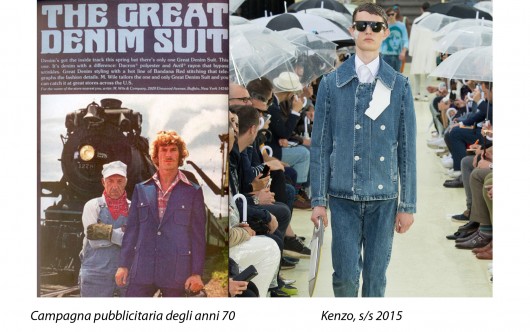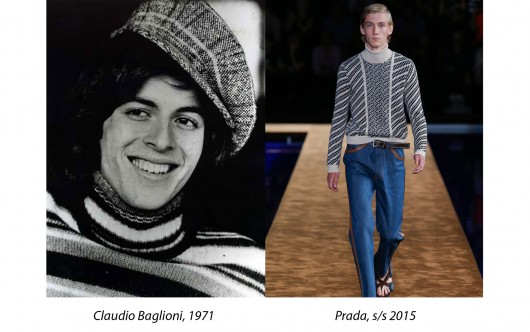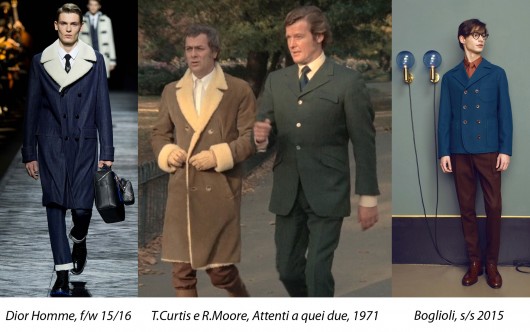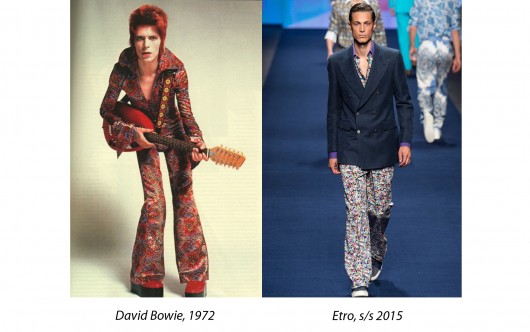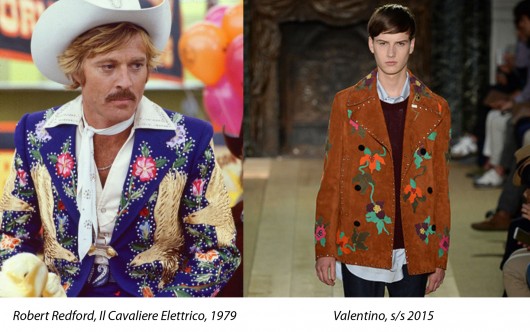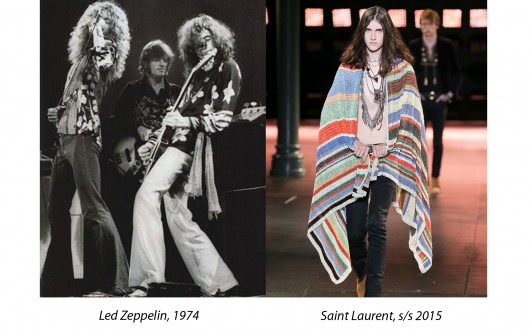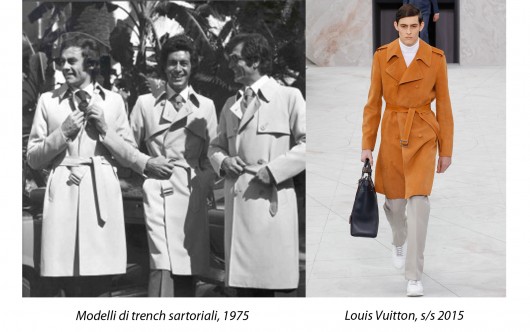70s RULE AGAIN
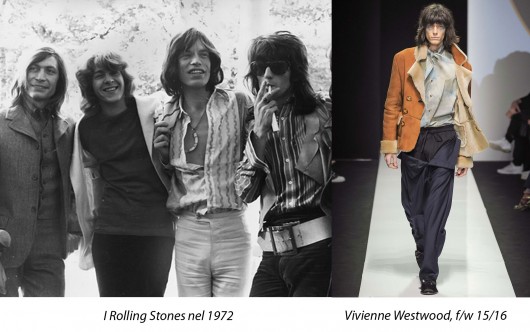 Si respira nuovamente il sapore degli anni Settanta nel panorama, da anni ormai fluido e sfaccettato, della moda Uomo? Pare proprio di sì. Sarebbe improprio parlare di déja vu. L’aria è nuova, ma i richiami sono forti ed inequivocabili. Richiami, che si articolano un po’ a tutto campo: non si limitano, alla sola conformazione dei capi, coinvolgendo anche l’approccio al colore ed alla materia, certe lavorazioni, lo sguardo rivolto alle culture differenti e ad orizzonti extra-occidentali.
Si respira nuovamente il sapore degli anni Settanta nel panorama, da anni ormai fluido e sfaccettato, della moda Uomo? Pare proprio di sì. Sarebbe improprio parlare di déja vu. L’aria è nuova, ma i richiami sono forti ed inequivocabili. Richiami, che si articolano un po’ a tutto campo: non si limitano, alla sola conformazione dei capi, coinvolgendo anche l’approccio al colore ed alla materia, certe lavorazioni, lo sguardo rivolto alle culture differenti e ad orizzonti extra-occidentali.
Va tenuto presente un dato essenziale: fermo restando che le figure di riferimento sono personaggi noti, negli anni Settanta entra nell’accezione comune un approccio al vestire già sperimentato nella seconda metà del decennio precedente, a cavallo tra l’era beat ed il flower power.
Ma, se sino alla fine dei Sessanta il “nuovo” volto dello stile al maschile era osato da singole categorie – giovani e studenti in primo luogo, artisti, intellettuali e fashion addicted – successivamente esso diventa di massa ed entra negli uffici, nelle imprese, nelle banche, nei cosiddetti salotti buoni e diventa davvero di tutti, manifestandosi su larga scala per le strade e persino all’uscita delle fabbriche, che ancora esistevano…
Ciò che prima era stravaganza, ora è “la moda”. Si può partire dal mutamento delle proporzioni che assumono sia i capi in toto, sia le loro singole parti. Un dato evidente riguarda il pantalone, che si allargano, e non poco, verso il fondo. Nel linguaggio comune si parla di pantaloni a “zampa d’elefante”. Allo stesso modo si ampliano i colli delle camicie – a “becco d’oca” – e un po’ tutti i revers: della giacca, dei trench, dei cappotti. Assumono misure extra le cravatte, mentre i papillon assumono talvolta aspetti un po’ clowneschi.
Intanto le città si colorano. Nessuno è più vincolato al grigio/blu/marrone. Quasi tutto è in technicolor: camicie, pullover, completi interi o spezzati. Per non parlare degli accessori: cravatte, foulard – quasi un must, portati fuori dal collo extra – persino le scarpe, che adottano il plateau – al tempo detto “zeppa” – come quelle femminili.
 La maglieria diventa terreno fertile per le variazioni sul tema delle fantasie: i capi, che siano pullover girocollo o cardigan poco importa, hanno lavorazioni spesso molto corpose e patterns in contrasto cromatico che oggi chiameremmo etnici. In qualche modo il flower power cede il passo o forse si evolve nel color power.
La maglieria diventa terreno fertile per le variazioni sul tema delle fantasie: i capi, che siano pullover girocollo o cardigan poco importa, hanno lavorazioni spesso molto corpose e patterns in contrasto cromatico che oggi chiameremmo etnici. In qualche modo il flower power cede il passo o forse si evolve nel color power.
A proposito di etnico: l’India tardo-Beatles non è più il solo orizzonte lontano a cui guardare. Si riscopre lo stile Western: diventa abituale veder circolare total look in denim, o quantomeno jeans jacket da cow boy sempre ben ravvicinate al busto e/o giacconi in pelle più generosi nelle dimensioni, indossati anche sopra i business suit. Ci si avvicina alla cultura dei nativi americani e compaiono i primi blouson in shearling, non di rado decorati da ricami e applicazioni.
Vale lo stesso per il mondo celtico, con il tartan che la fa da padrone, o anche per la Russia degli zar che ritorna nel look da mugiko: casacca elementare di tessuto povero come il pantalone ampio, infilato negli stivali a metà polpaccio. “Grazie” ad un generale golpista cileno, Augusto Pinochet, tutto il mondo si accorge del folklore andino e il poncho arriva sotto la luce dei riflettori, mentre non poche disegnature animano altre tipologie di capi in maglia.
La lezione di moda dei Settanta, se così possiamo chiamarla, parla certamente di libertà, di visioni aperte e di desiderio di osare che non riguarda più solo gli addetti ai lavori. Indubbiamente molti codici di quel decennio scompaiono alla vista poco dopo. Ma non vanno affatto persi. Lo dimostrano le passerelle di oggi. A quaranta anni di distanza. Giorgio Re
Are Seventies back again in menswear? The answer is yes. But we can’t talk about déja vu. The concept is new, but the references are remarkable and clear. References that involve many perspectives: shapes, colours, fabrics, manufacturing, other cultures’ influence. But consider a fundamental fact: it being understood that the reference models were the celebrities, in the Seventies an approach to fashion that had been already tested in the late 60s, between the beat and flower power eras, was common. But, if until the end of the 60s the “new” side of menswear was dared by single categories – young people and students, artists, intellectuals and fashion addicted – then it became off-the-shelf and was adopted in offices, factories, banks, in the so-called parlors…What was extravagance, became “in”. There was a change both in the general proportions of the clothes and in the details. Just think about the trousers, that became “bell-bottom”. At the same time the shirts’ collars became larger, as the lapels of jacket, trench coats, coats. X-size for ties and bow-tie, which became a little clownish. At the same time cities “painted” themselves. Nobody was bounded to grey/blue/brown. Almost everything was in technicolor: shirts, sweaters, suits – and the accessories: ties, scarves – a must-have, worn outside the collar – even shoes, that had a plateau as the women’s ones. Knitwear became breeding ground for patterns: round-necks and cardigans had often rich-weaves and contrasting patterns, that today we may call ethnic. The flower power evolved in color power. Talking about ethnic: India of the late-Beatles era wasn’t the only far reference horizon anymore. There was a rediscovery of the Western style: denim total looks, or fitted denim jackets and/or wider leather heavy jackets, worn even over business suits. Hints of the Native Americans’ culture appeared in the first shearling blousons, often embellished with embroideries and beads. The same thing for the Celtic world, with an explosion of tartan, or also for Russia, that came back with the mugiko look: simple jacket made of rough fabric as the wide trousers, worn inside the calf-lenght boots. “Thanks” to the Chilean general Augusto Pinochet, the world took notice of the andean folklore and the poncho came to the spotlight, while typical patterns appeared on other kind of knitted garments. The Seventies in terms of fashion taught us, if we can say so, freedom, open mind and desire of daring, not only relating to fashion people. Surely many codes of that decade vanished little time later. But they didn’t get lost. A demonstration are the catawalks of today. Fourty years later. Giorgio Re





